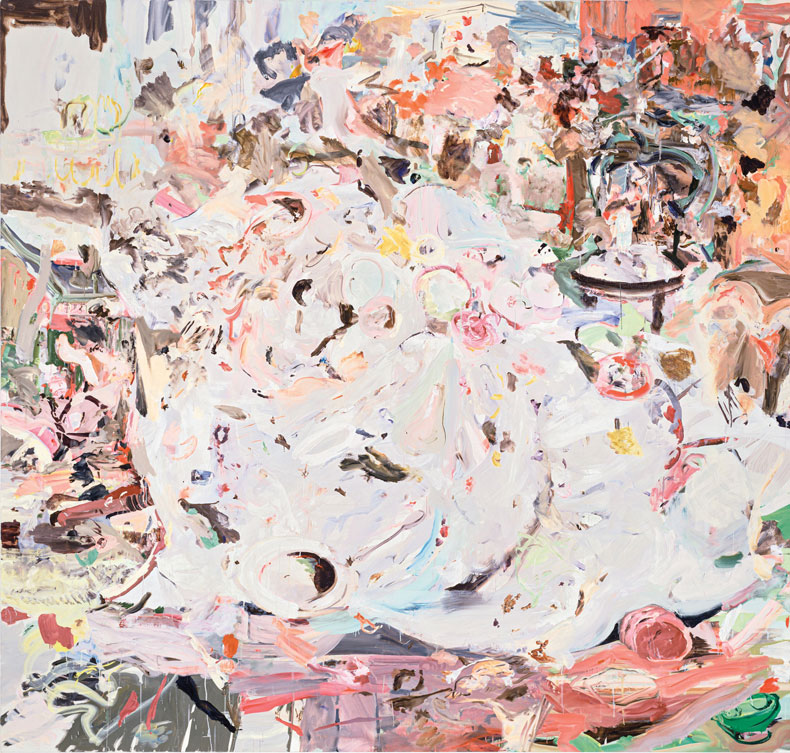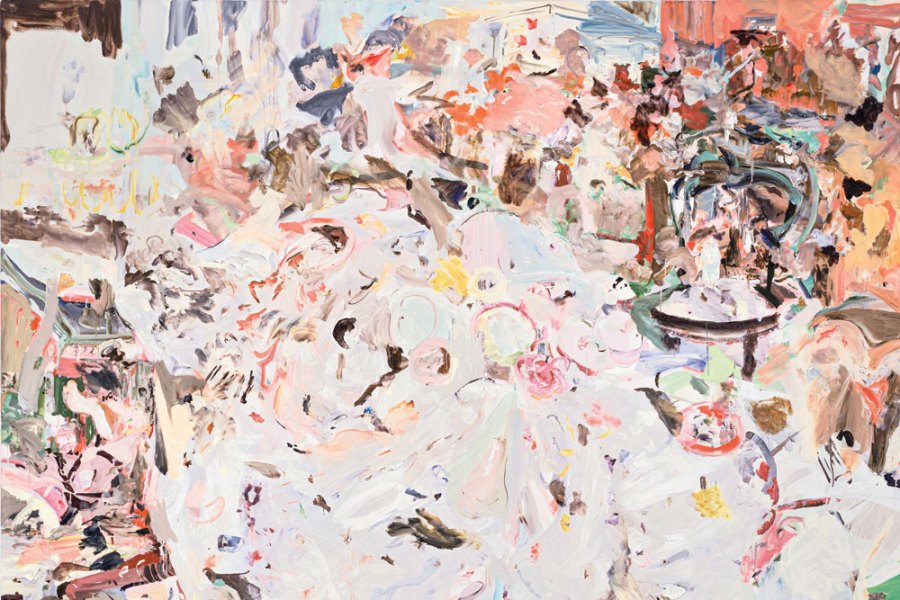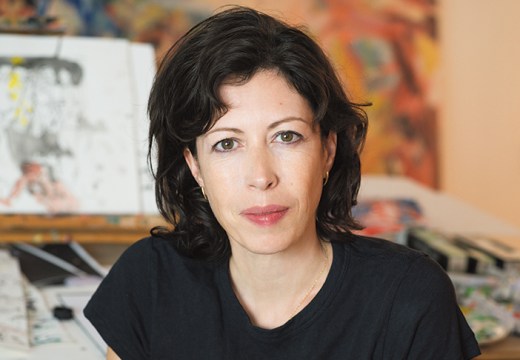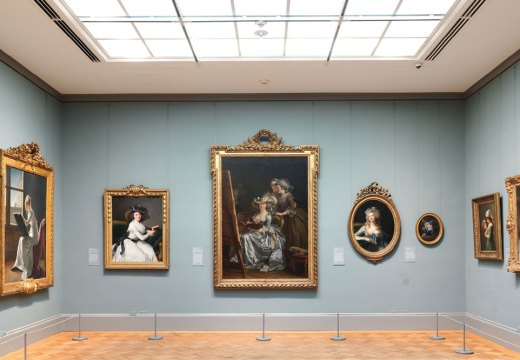From the July/August 2023 issue of Apollo. Preview and subscribe here.
Cecily Brown describes her struggle to render figurative images with a question: ‘How do you keep openness, and different ways in, if fundamentally the picture is a closed image?’ Brown’s difficulty with what she calls ‘clear figuration’ is that such images are ‘sealed’. Her aim to open up and activate the space of a painting and to invite the viewer into it for an extended stay helps to explain why she renders figurative and representational elements in an abstract idiom. This combination offers multiple ‘entry points’, as she puts it: recognisable images, such as a bowl of fruit or a woman at a dressing table, rendered in a flurry of brushstrokes that forestalls fixed readings. As one critic has written, it’s a style that ‘hovers between abstraction and figuration’. What to make of that in-between status, one that alights neither here nor there? ‘Death and the Maid’, the Metropolitan Museum of Art’s survey of 25 years of Brown’s art – work she made after moving to New York from London in 1994 – doesn’t aim to find out.
Brown’s complex style goes unexplored in this show, which instead focuses on the relationship between her art and its source material (work by artists such as Manet, Rembrandt, Bacon and Soutine), illustrating two entwined themes that thread throughout her work: images of youth and beauty merged with memento mori and vanitas and interpretations of 17th-century Flemish and Dutch still lifes that dramatise the transience of existence. Divided into these halves, the exhibition – some 50 oils, watercolours, drawings, monotypes, and sketches – can be entered at either end of the gallery, which is aptly bookended by collection highlights devoted to abstraction and the theme of ‘Work and Industry’.
The Met’s curator Ian Alteveer suggested the exhibition’s title, inspired by Schubert’s ‘Death and the Maiden’ quartet. In the accompanying catalogue, he writes that Brown’s paintings, like Schubert’s composition, ‘play with theme and variation’, especially under the sign of death and the macabre (qualities that, for Brown, were thrown into relief by the Covid-19 pandemic). Brown opted to shorten ‘Maiden’ to ‘Maid’, a nod in part to her youthful work cleaning flats in London. The feeling of moving through private spaces animates some of the best work in the show. Adoration of the Lamb (2005–06) depicts a wildly unkempt interior: a mass of objects piles up near the centre of the canvas in a heap of colours and brushstrokes. Brown reins in the disorder by surrounding it with large sections of lavender and mauve at the top of the painting and strategically deploying daubs and strokes of yellow around the mess, hemming it in and diverting its movement toward the bottom left of the canvas, where it comes into contact with a staircase that climbs the lower left side of the composition.

Memento Mori I (2006–08), Cecily Brown. Private collection. Courtesy the Metropolitan Museum of Art, New York; © Cecily Brown
Brown’s paintings are best when she devises such organising principles, which allow the disorder of her maximalist compositions to retain legibility. The constraints also set the paintings in motion. Brown has said that she thinks of her canvases as spaces for performance: ‘In the end, what the painting becomes is a record of your movements. It really is very close to dance.’ Her use of abstract marks to describe representational settings recalls the flecked aqua chairs that enliven the room in Little Girl in a Blue Armchair (1878) by Mary Cassatt or the delicate spray of city lights and fireworks in Whistler’s Nocturnes. In Brown’s work, small representational details emerge from the sea of abstraction like lagan. In Memento Mori I (2006–08), a spoon appears amid the central tumble of a white tablecloth being pulled to the floor, specked with dashing daubs of colour. The curved neck of a dead goose drapes elegantly from a brutal riot of red and black in an untitled drawing from 2021 made after Frans Snyders. The wonderfully immoderate Carnival and Lent (2006–08), which draws from Pieter Bruegel the Elder’s The Fight Between Carnival and Lent (1559), balances the frenetic cluster of bodies near the centre of the canvas with larger, brushier sections toward the top, giving the same sense of panorama and perspectival depth as Bruegel’s original, but with a distinctly orgiastic mood.
In Brown’s best work, abstraction and representation are in dialogue, and she uses this relationship to trouble scale, introduce movement and unsettle the viewer’s relation to the art. In The Only Game in Town (1998), rather than seeing her own reflection, a woman gazing into her dressing mirror is met by a ferocious double, while an outsize eyeball (a stand-in for the viewer perhaps) presses viscerally against the scene. Often, though, Brown’s gestural marks overwhelm her subjects. The hectic surface of Father of the Bride (1999) conceals the figure, or muddies it, crowding it in such a way that the figure seems lesser, or less decisive, for all the intervening marks. Like its title, the painting Blood, Water, Fruit and Corpses (2017) contains too much, with no formal element that binds it all together.
Arranged thematically, rather than chronologically, the exhibition offers little sense of how Brown’s art has developed over the last quarter century. The themes and concerns intended to connect the work instead stifle it. Where is the eroticism in her art, which so often invigorates both style and subject, or the bright, spontaneous monotypes she produced in 2019, in which the nimble lines of her drawings are on display? The show’s dogged emphasis above all on the linkage between Brown’s work and Old Masters, still lifes and turn-of-the-century advertisements and illustrations – the way one can see the earlier work writ literally in her canvases – doesn’t help. Giving half the show over to her interest in memento mori, depicted often through imagery borrowed from kitschy Victoriana, feels repetitive – so many skulls hidden among sedate, ruffled girls or women seated at their dressing tables. According to the curatorial text, every work here provides some take on the certainty of death and the betrayal of the physical body. After a while, this show becomes less of a survey than a closed circuit.
‘Cecily Brown: Death and the Maid’ is at the Metropolitan Museum of Art, New York, until 3 December.
From the July/August 2023 issue of Apollo. Preview and subscribe here.
Unlimited access from just $16 every 3 months
Subscribe to get unlimited and exclusive access to the top art stories, interviews and exhibition reviews.














![Masterpiece [Re]discovery 2022. Photo: Ben Fisher Photography, courtesy of Masterpiece London](http://www.apollo-magazine.com/wp-content/uploads/2022/07/MPL2022_4263.jpg)
Has the Fitzwilliam lost the hang of things?